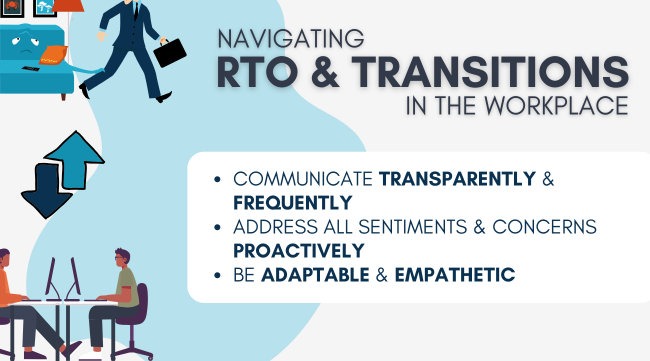
Navigating return-to-office (RTO) transitions remains a priority for organizations, their leaders, and their people. In today’s professional landscape, some companies are fully back to operating in person, while some continue to embrace hybridity and flexible work amid evolving workplace needs. 70% of workplace executives plan to maintain or increase the number of in-office work days this year. Whether your company is enforcing new in-office mandates or redesigning its hybrid model, effectively navigating workplace changes requires strong leadership, clear communication, and a collective mindset shift. With intentional practices, organizations can create harmony and adaptability amid transition.
Communicate: Transparently & Frequently
Open, transparent communication is the foundation of a successful transition. Both leaders and employees need proactive updates, not just reactive responses. Leaders should clearly articulate what changes are occurring, why they are happening, and how they will impact teams. Communicating clearly, ensuring everyone in the organization fully understands the objectives, strategy, rationale, and policies when implementing workplace change, and ensuring it is done with purpose, is critical. It’s important to have these conversations prior to rolling out these changes or transitions to ensure they’re not a surprise. This allows time for all employees to prepare, ask questions, and make sense of these changes. According to SHRM, this level of transparency can reduce confusion and increase alignment across the organization.
Address Conflicting Sentiments & Concerns Proactively
Remember to frame any RTO not as a mere change, but a transition for the organization as a whole to try and diminish negative feelings people naturally associate with change. Changes like RTO are not just a shift in policy; it’s a human transition. Emotions like resistance, anxiety, or disengagement are normal responses. Instead of pushing back against them, leaders should acknowledge and proactively address them. Encourage open dialogue and enforce feedback loops. This enhances psychological safety and fosters a workplace culture built on trust. As Fast Company notes, top-down mandates without empathy can damage morale, so it’s critical to balance structure with support. By positioning transitions like this and making an effort to ensure voices are heard and understood, undergoing change will be more digestible for everyone.
Adaptability & Empathy are Key
As organizations, their leadership and employees navigate workplace change, it’s essential to acknowledge that change can bring uncertainty and emotions in this shared journey. Organizations, managers, and employees alike must approach RTO and workplace transitions with a flexible and empathetic mindset. Adaptability means being willing to revise strategies, timelines, and expectations based on addressed feedback and results, as well as offering flexibility where possible. Whether you’re a manager, a new hire, or a seasoned employee, navigating workplace change with empathy, awareness, and intention is what sets great workplaces apart.

Workplace changes are not a temporary phase; they’re part of organizational growth and evolving workplace needs. By communicating openly, addressing concerns head-on, prioritizing psychological safety, and embracing adaptability, organizations can lead with resilience and unity. Regardless of your role, remember that RTO and workplace changes aren’t about returning to the past; they’re transitions with the purpose of designing a better, more thoughtful future of work that benefits all members of the organization.
Subscribe to The JOHNLEONARD Blog below for more tips to improve your workplace culture.
